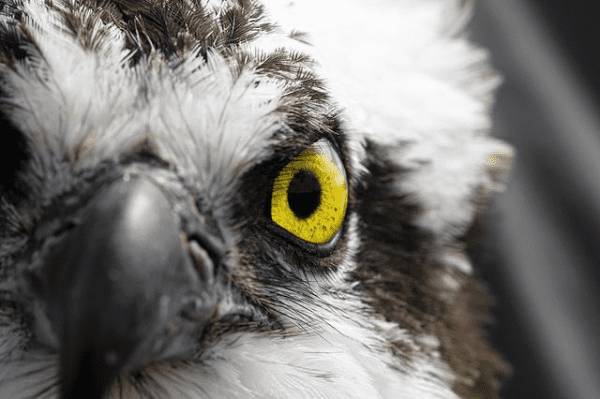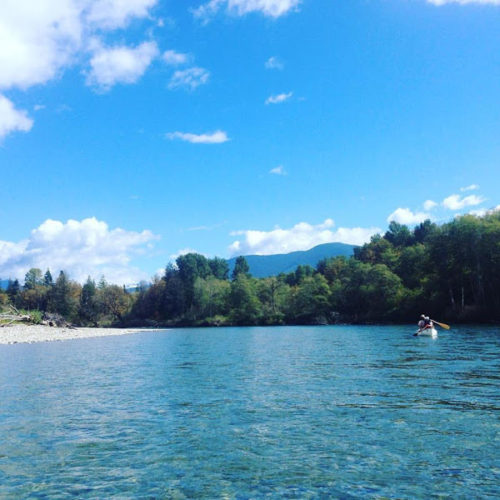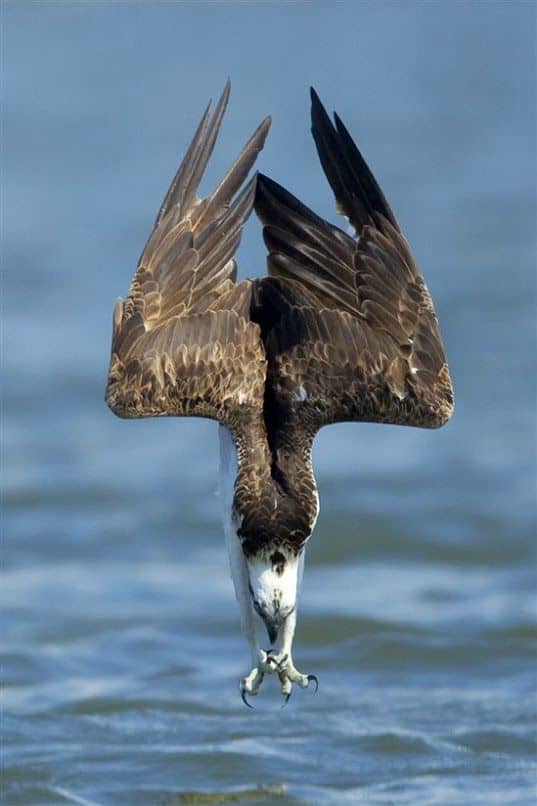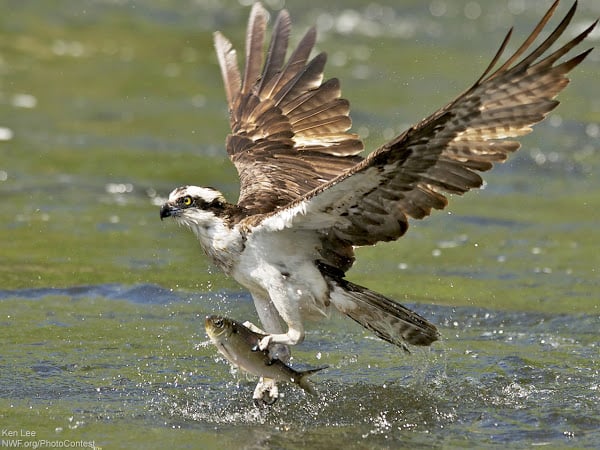
The Great Fisher
By Smokey Brine, graduate student in the Institute’s 16th cohort.
A warm summer wind funnels down the Skagit River, blowing wisps of brown hair in front of my eyes. I shift my head to regain sight of the river channel and spot a green canoe cutting the water in front of me. The three passengers are laughing at something, I can hear their muffled exclamations over the sound of the rapids chopping against my boat. I attempt to propel my kayak closer to their conversation; clearly I am missing out on some sort of hilarity with my new housemates. When I catch up the river is now calm. I look to my friends and notice their gazes are focused downriver but not at the oncoming curve. Instead, they look upward.
Further downstream the Skagit River curves south, continuing its course from high in the formidable North Cascade mountains to the Salish Sea and the Pacific Ocean. Behind me is a wall of snowy peaks cutting the sky. In front, rounded tree-covered hills roll slowly seaward. The frost-bitten-blue color of the water beneath me hints at the river’s glacial origins and it seems that the clear blue of the westward sky is not quite as beautiful as the water below.
Ahead, before the riverbend, I spot the thing that has made my friends so watchful; a dark speck is hovering above the azure water. It seems motionless, as if suspended in time. It suddenly plunges downwards and I recognize the spectacle as the osprey crashes head-and-talon first into the water. An audible gasp issues from both our boats and we watch as the enormous bird rises from the water with a large fish clutched in its talons. The luckless fish, what appears to be a trout, is limp in the bird’s grasp. The hunter is successful.
As the osprey beats its wings skyward I sink my paddle into the water, attempting to fight the current pushing me away from the bird and its catch. I round the bend and see the distinctive “M-shaped” wings moving the raptor away from our canoeing party, upstream of a small tributary feeding into the Skagit. Its underbelly flashes bright white and I am almost forced to look away. As it shrinks into the distance, the brown of its back feathers begins to blend in with the surrounding trees. The white underneath its wings and stomach disappears and I am amazed at how eagle-like this bird looks from far away. I slowly lose sight of it. I imagine the bird is heading to a nest; perhaps there are chicks that need to be fed.
The bend ahead suddenly swoops us round the corner. We continue our journey and as the green landscape drifts by I find myself frequently looking up, searching for another fisher in the sky.

Canoeing down the Skagit River. Photo by Smokey Brine
Most of my life has been lived by the water and, subsequently, by ospreys. I spent many lazy Saturdays in my early years watching a pair of ospreys hunt the shallow waters of Ken Lake in Olympia, Washington. As the years progressed I moved to new places yet still managed to see these birds wherever I went. In Eugene, Oregon I occasionally saw a haggard osprey hunting for food in the muddy waters of the Willamette River. I passed by an osprey nest along the Clark Fork River in Montana everyday on my way to class. Today, I live near the banks of the Skagit. My memory of our first float and the osprey hunt resurfaces every time I walk down to the water’s edge. It seems these charismatic birds and I have been linked by location most of my life. Until now, I have known very little about the species and this seems shameful, like living out a life next to a friendly neighbor and never once bothering to knock on their door.
All these years I have been watching a very skilled hunter and an extremely perceptive being, far more intelligent than I first realized. Ospreys have a particular set of adaptations that allow them to thrive in a niche no other raptor in the region can fill – they alone are the Great Fisher.
When I go fishing, which is not often, I usually bring a fishing rod, hooks, and perhaps some bait (if I’ve really thought ahead). When an osprey launches from her nest and goes in search of fish, she is far better equipped than I – her tackle box has been with her since birth.
An osprey hunts by slowly flying over a body of water, looking for fish close to the surface. When prey is spotted, the hunter will hover 30-150 feet overhead, zeroing in on her target. This brief suspension in space allows the bird valuable preparation time before rocketing downwards at the unsuspecting fish. The dive is quick and provides only moments to adjust the trajectory before the osprey hits the water. The angle and speed of the dive will depend on the type of fish the osprey is hunting. A low-flying shallow dive is more useful for fast, surface-level fish but a steep dive from high above the water will be better for those deeper, slower fish. When the osprey hits the water, the force of the impact is powerful and although this raptor can only go about 3 feet under the surface, the hunter’s long legs allow her to reach further into the shallows for her food.

Osprey diving for fish. Image courtesy of Pinterest
An excellent hunter, ospreys have high catch rates. On average, an osprey will spend about 12 minutes searching for prey until she is successful. Once the osprey has caught a fish, she uses her powerful wings to rend herself from the water and back into the sky. An opposable back toe makes gripping the fish in her talons especially easy. Barbed hooks on the pads of the talons keep the slippery catch from slithering its way out of the osprey’s grip. As the bird flies back to her nest she will turn the fish headfirst into the wind. The osprey is well practiced in aerodynamics.
Hunts are typically short, but this is not only because of skill and physiology. Ospreys are intelligent creatures and they will not go hunting willy-nilly all over the river channel until they happen upon a fish. Like most raptors, these birds have a keen sense of sight and they can identify a species of fish long before any of us would even begin fumbling for our binoculars.
For ospreys that live in small colonies, watching each other is key. When one bird goes out to fish and comes back successful, another individual on their way out will pay close attention to their peer’s catch. If they see a fish that travels in schools clutched in the returning bird’s talons, the hunter will make straight for where the other bird was just fishing. If the species of fish is not a social one, the osprey will look elsewhere for food. Logic, along with talent, is factored into the hunt.

Osprey with catch. Photo by Ken Lee
These creatures are born to fish. Their anatomy and behavior gives them the tools to catch the most elusive prey. Among the fish-eating birds, ospreys are the most charismatic in their hunting practices. If you have ever seen an osprey crash into the water and emerge soaked but successful with a fish clutched in its powerful talons you know this to be true.
After years of watching these birds, I am still mesmerized by the sight of an osprey dive. They approach the world with an unapologetic willpower. There are no shortcuts with these creatures. An osprey earns every fish. It takes skill and talent, honed over generations, to keep an osprey’s belly full. When an osprey hunts, I see in their momentum an evolutionary brilliance careening downwards to culminate in a perfect dive. Nature and time have together created an angler of unmatched prowess and skill. And so it is by the march of centuries and the osprey’s fearless spirit that these birds of earned the name “the Great Fisher”.
Title photo by B. Gregson

